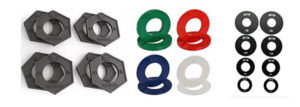
The goal in weight training is to create a training environment that allows your body to make adaptations that result in bigger stronger muscles. Training can be done in a way that makes it easy for your body to adapt, or it can be done in a way that makes it hard for your body to adapt. Of course your goal should be to create training conditions that make it easy for your body to adapt by gaining strength.
When Adaptation is Easy
In order to train strategically, it is important to understand that adaptation is easy if you have a large reserve of adaptive capacity. Unfortunately, your reserve of adaptive capacity is generally used up more and more as you continue to grow stronger. If you have not yet used up very much of your reserve of adaptive capacity, your strength gains will tend to be bigger, faster, and easier.
The Problem with Big Adaptations: They Are Not Sustainable
The problem with big adaptations is that your body can’t keep repeating them on a long term basis. If your training is designed to demand big adaptations when your body has run out of the capacity to do so, it doesn’t adapt at all and strength gains cease. This doesn’t mean that your body can’t make any adaptations, it just means that your body cannot keep making big adaptations in the form of rapid strength gains.
Small Adaptations Are Easy For Your Body to Make
When your body reaches the point where it can’t make big adaptations, it still has the capacity to make small adaptations. Small adaptations are much easier for your body to make and small adaptations can be repeated over and over to accumulate into big adaptations.
Add Weight in Small Increments for Easy Adaptation
Easy adaptation will occur when you use the right training strategies. One of the strategies that will help you to accomplish this is to add weight to your lifts in small increments.
Additions of 5 to 10 Pounds Per Week are not Sustainable
If you add five to ten pounds of weight to your lifts every week, you will be using an additional 50 to 100 pounds in just ten weeks of training. That’s a lot of weight in a short amount of time and it is unrealistic to believe that most people can make gains like that for more than three to six months. Some simple math will reveal that adding five to ten pounds to your lifts every week will add up to 250 to 500 pounds in a year, and 750 to 1500 pounds in three years.
Hopefully you can see that adding five to ten pounds to your lifts each week is not a sustainable process. When you try to force your body to make big adaptations that exceed its adaptive capacity, it often quits making any adaptations at all. The result is that strength gains cease.
Fractional Weight Plates: A Major Key to Sustainable Progress
You can easily solve the problem of surpassing your body’s adaptive capacity by reducing the amount of weight that you add each time. Even though this is a simple idea, most people can’t do it because they don’t have the right equipment. The smallest weight plates that can be found in most gyms are two and a half pound weight plates. When you add two and a half pounds to each side of a barbell it adds up to five pounds. It doesn’t seem like a lot of weight, but there will come a time when your body no longer gains strength in five pound increments. Many lifters have figured this out and use fractional weight plates that weigh a pound or less in order to keep making progress. Some people may believe that adding small amounts of weight to your lifts is a sign of ineffective training, but if you add a half pound to each side of barbell every week, you will be fifty pounds stronger at the end of a year. This is far better than adding too much weight and failing to gain anything at all.
Inch By Inch Is a Cinch, but Yard by Yard Is Hard
There is a saying that, “Inch by inch is a cinch, but yard by yard is hard.” When you apply this principle to weight training, it means that it is easy to keep making progress when you add weight in very small increments, but it is hard to keep on making progress when you add weight in bigger increments.
Microloading
Adding very small amounts of weight is often referred to as microloading in weight training circles. If your body has run out of the capacity to gain in five to ten pound increments, fractional weight plates can be used in order to start making progress again by microloading.
Of course before you can start microloading, you need fractional weight plates. Fractional weight plates are often hard to find at stores that carry weight training equipment. If you are considering microloading, but you don’t have fractional weight plates, you can easily find them by visiting the following link:
